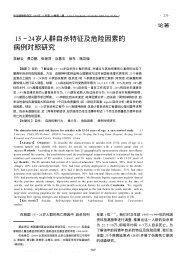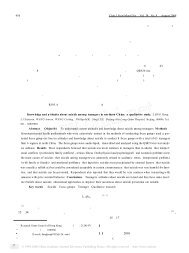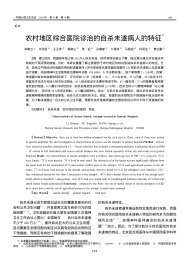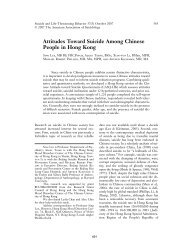Interventions for Suicide Survivors: A Review of the Literature
Interventions for Suicide Survivors: A Review of the Literature
Interventions for Suicide Survivors: A Review of the Literature
You also want an ePaper? Increase the reach of your titles
YUMPU automatically turns print PDFs into web optimized ePapers that Google loves.
Jordan and McMenamy 345<br />
uated interventions specifically designed <strong>for</strong> surround <strong>the</strong> survivor. O<strong>the</strong>r areas that may<br />
survivors are somewhat more promising, and show differences in <strong>the</strong> bereavement expe-<br />
also have similar implications <strong>for</strong> future re- rience include <strong>the</strong> impact <strong>of</strong> suicide on <strong>the</strong><br />
search and clinical intervention. Most <strong>of</strong> <strong>the</strong> assumptive world <strong>of</strong> survivors and possible<br />
studies found at least some effect <strong>for</strong> <strong>the</strong> in- long-term “sleeper” effects, particularly <strong>for</strong><br />
tervention and also report high levels <strong>of</strong> children who lose parents to suicide.<br />
participant satisfaction with <strong>the</strong> services. Un- There is also a lack <strong>of</strong> consensus about<br />
<strong>for</strong>tunately, <strong>the</strong> methodological rigor <strong>of</strong> <strong>the</strong> whe<strong>the</strong>r <strong>the</strong>re is a universal pattern <strong>of</strong> re-<br />
studies has generally been weak, with many sponse among suicide survivors, or alternaresearchers<br />
failing to utilize random assigntively, a diversity <strong>of</strong> responses that are influment<br />
and appropriate comparison groups. enced by variables over and above <strong>the</strong> loss.<br />
Moreover, <strong>the</strong> studies that have employed This suggests <strong>the</strong> need <strong>for</strong> continuing re<strong>the</strong><br />
most careful research designs (Kovac & search into which factors tend to produce<br />
Range, 2000; Murphy et al., 1998; Pfeffer et which types <strong>of</strong> responses <strong>for</strong> which groups <strong>of</strong><br />
al., 2002) also tended to find <strong>the</strong> least confir- survivors (Farberow, 2001). In addition, very<br />
mation that <strong>the</strong> interventions were success- little is known about <strong>the</strong> coping strategies<br />
ful. Hence, while <strong>the</strong>re is anecdotal evidence that survivors develop on <strong>the</strong>ir own, and only<br />
and a general clinical impression that services slightly more about what types <strong>of</strong> <strong>for</strong>mal and<br />
are helpful, we must conclude that <strong>the</strong> effi- in<strong>for</strong>mal assistance survivors receive from<br />
cacy <strong>of</strong> <strong>for</strong>mal interventions <strong>for</strong> survivors has pr<strong>of</strong>essional caregivers, family, friends, and<br />
yet to be scientifically established. The state o<strong>the</strong>rs in <strong>the</strong>ir social network. Careful longi<strong>of</strong><br />
our knowledge about how, when, and with tudinal research with a diverse, community-<br />
whom to intervene after a suicide is still quite based sample <strong>of</strong> survivors would greatly in-<br />
primitive, suggesting a pressing need <strong>for</strong> furcrease our understanding <strong>of</strong> <strong>the</strong> challenges<br />
<strong>the</strong>r research that addresses several key is- involved and <strong>the</strong> coping skills required after<br />
sues. We turn to this topic in <strong>the</strong> final section a suicide. It would also provide much needed<br />
<strong>of</strong> this article. in<strong>for</strong>mation about <strong>the</strong> large number <strong>of</strong> survivors<br />
(quite likely <strong>the</strong> majority) who never<br />
Recommendations <strong>for</strong> Future Research attend organized support groups or receive<br />
pr<strong>of</strong>essional assistance. Such research would<br />
The first need is <strong>for</strong> better in<strong>for</strong>mation allow us to generate creative strategies <strong>for</strong> inabout<br />
<strong>the</strong> “natural” course <strong>of</strong> bereavement tervention that build on <strong>the</strong> natural coping<br />
after suicide. We have not yet definitively an- ef<strong>for</strong>ts that different types <strong>of</strong> survivors typiswered<br />
<strong>the</strong> question as to what, if any, differ- cally make and <strong>the</strong> support resources <strong>the</strong>y<br />
ences exist between suicide bereavement and utilize. Differences in coping strategies based<br />
o<strong>the</strong>r types <strong>of</strong> losses (Clark, 2001). Mc- on gender, personality, and cultural differ-<br />
Intosh’s (1999) summary <strong>of</strong> <strong>the</strong> literature ences need to be studied and incorporated<br />
concluded that most suicide bereavement is into treatment planning. To summarize, it<br />
nonpathological, suggesting that whatever seems likely to us that <strong>the</strong> “one size fits all”<br />
differences exist between bereavement after approach to understanding and intervening<br />
suicide and o<strong>the</strong>r types <strong>of</strong> losses appear to with survivors which has been dominant<br />
disappear after <strong>the</strong> first 2 years. Jordan (2001) since <strong>the</strong> inception <strong>of</strong> modern suicidology<br />
has also reviewed this literature and reached needs considerable refinement (Ellenbogen<br />
a more complex conclusion, suggesting that & Gratton, 2001).<br />
while quantitative evidence <strong>for</strong> differences in Second, we need methodologically sound<br />
outcome has received only mixed support, studies <strong>of</strong> <strong>the</strong> efficacy and effectiveness <strong>of</strong><br />
<strong>the</strong>re appear to be important distinctions in <strong>for</strong>mal interventions <strong>for</strong> survivors. Given <strong>the</strong><br />
<strong>the</strong> <strong>the</strong>matic content <strong>of</strong> <strong>the</strong> grief experience present state <strong>of</strong> knowledge, we believe that it<br />
<strong>for</strong> many survivors, in addition to differences is generally premature to study comparative<br />
in social support and family processes that treatment interventions at this time. Since

















